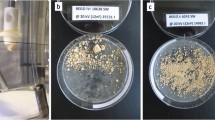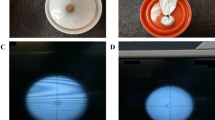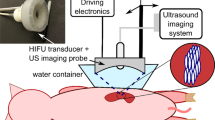Abstract
Storz Medical AG (Kreutzlingen/Switzerland) has developed a new electromagnetic shockwave (SW) generator, the “SLX-F2”, which allows the user to choose between a small-focus, high-pressure treatment regime or a wide-focus, low-pressure option. The aim of this study was to investigate, under standardized conditions, the impact of these two different treatment regimes on SW-induced renal injury. SW-induced renal injury was investigated by using the standardized model of the perfused ex vivo kidney. SWs were applied under ultrasound control in the parenchyma of a kidney pole. Different SW numbers (20, 50, 125, 250, 500, 1,000) were applied in three groups: group A was treated with a wider focus (80 MPa), groups B (60 MPa) and C (120 MPa) with a smaller focus (each parameter setting was repeated ten-fold). Disintegration capacity (measured by crater volume in cubes of plaster of Paris) was the same in groups A and C. After SW exposure, barium sulphate suspension was perfused through the renal artery. The maximum diameter (mm) of the extravasation in the cortex, representing the extent of vascular injury, was measured on X-ray mammography films. H&E staining was performed. In all three groups (A, B, C) a higher number of SWs caused the diameter of the extravasate to increase, with statistical significance appearing at 1,000 shots versus 20 shots (p < 0.05). Vascular injury was not influenced by the focal size and positive peak pressure at identical SW numbers applied. Histology of the focal area showed gap-like defects. Our ex vivo data show that renal vascular injury is independent of the focal diameter of the SW generator at the same peak positive pressure and disintegration power. This confirms the in vivo findings that show renal injury caused by SW as being related to the number of SWs administered. Clinical studies are needed to investigate whether there is any advantage to offering both treatment regimes in one SW machine—for example, by using the “wide-focus, low-pressure” option for kidney stones and the “small-focus, high-pressure” regimen for stones in the ureter. The renal injury caused by either regime remains comparable.





Similar content being viewed by others
References
Tiselius HG, Ackermann D, Alken P, Buck C, Conort P, Gallucci M (2001) Guidelines on urolithiasis. Eur Urol 40:362–371
Rozenberg LD (1969) (ed) Ultrasonic focusing radiators. Sources of high-intensity ultrasound. Plenum, New York
Steiger E, Marlinghaus E (1997) Modeling the Storz MODULITH SL 10 shock wave lithotriptor. Second world congress on ultrasonics. Yokohama, Japan
Steiger E (1997) FD–TD-modeling of propagation of high energy sound pulses in lithotripter-tissue-arrangements. Proceedings IEEE International Ultrasonic Symposium 1997, Toronto, Canada
Willis LR, Evan AP, Connors BA, Shao Y, Blomgren PM, Pratt JH, Fineberg NS, Lingeman JE (2005) Shockwave lithotripsy: dose-related effects on renal structure, hemodynamics, and tubular function. J Endourol 19:90–101
Köhrmann KU, Back W, Bensemann J, Florian J, Weber A, Kahmann F, Rassweiler J, Alken P (1994) The isolated perfused kidney of the pig: new model to evaluate shock wave-induced lesions. J Endourol 8:105–110
Bergsdorf T, Thuroff S, Chaussy C (2005) The isolated perfused kidney: an in vitro test system for evaluation of renal tissue damage induced by high-energy shockwaves sources. J Endourol 19:883–888
Connors BA, Evan AP, Willis LR, Blomgren PM, Lingeman JE, Fineberg NS (2000) The effect of discharge voltage on renal injury and impairment caused by lithotripsy in the pig. J Am Soc Nephrol 11:310–318
Delius M, Enders G, Xuan ZR, Liebich HG, Brendel W (1988) Biological effects of shock waves: kidney damage by shock waves in dogs-dose dependence. Ultrasound Med Biol 14:117–122
van Dongen JJ, Grossi FS, Bosman FT, Schroder FH (1993) Quantitative and qualitative evaluation of renal injury induced by shock waves delivered with the Siemens C generator. J Endourol 7:379–381
Brewer S. (1988) Shock wave lithotripsy damage in human cadaver kidneys. J Endourol 5:35–40
Karalezli G, Gogus O, Beduk Y, Kokuuslu C, Sarica K, Kutsal O (1993) Histopathologic effects of extracorporeal shock wave lithotripsy on rabbit kidney. Urol Res 21:67–70
Neisius D (1989) Dose-dependent influence on canine renal morphology after application of extracorporeal shock waves with Wolf Piezolith. J Endourol 3:337–345
Koga H, Matsuoka K, Noda S, Yamashita T (1996) Cumulative renal damage in dogs by repeated treatment with extracorporeal shock waves. Int J Urol 3:134–140
Rassweiler J, Köhrmann KU, Back W, Frohner S, Raab M, Weber A, Kahmann F, Marlinghaus E, Junemann KP, Alken P (1993) Experimental basis of shockwave-induced renal trauma in the model of the canine kidney. World J Urol 11:43–53
Roessler W, Wieland WF, Steinbach P, Hofstaedter F, Thuroff S, Chaussy C (1996) Side effects of high-energy shockwaves in the human kidney: first experience with model comparing two shockwave sources. J Endourol 10:507–511
Connors BA, Evan AP, Blomgren PM, Willis LR, Handa RK, Lifshitz DA, Lingeman JE, Ying J (2006) Reducing shock number dramatically decreases lesion size in a juvenile kidney model. J Endourol 20:607–610
Delius M, Jordan M, Eizenhoefer H, Marlinghaus E, Heine G, Liebich HG, Brendel W (1988) Biological effects of shock waves: kidney haemorrhage by shock waves in dogs-administration rate dependence. Ultrasound Med Biol 14:689–694
El-Damanhoury H, Schaub T, Stadtbäumer M, Kunisch M, Störkel S, Schild H, Thelen M (1991) Parameters influencing renal damage in extracorporeal shock wave lithotripsy: an experimental study in pigs. J Endourol 5:35–40
Mutscher R, Schmeller N, Reimers I, Kutscher K, Knipper A, Hofstetter A, Löhrs U (1987) ESWL-induced renal damage an experimental study. Invest Urol 2:94–97
Teichman JM, Portis AJ, Cecconi PP, Bub WL, Endicott RC, Denes B, Pearle MS, Clayman RV (2000) In vitro comparison of shock wave lithotripsy machines. J Urol 164:1259–1264
Howard D, Sturtevant B (1997) In vitro study of the mechanical effects of shock-wave lithotripsy. Ultrasound Med Biol 23:1107–1122
Zhong P, Zhou Y, Zhu S (2001) Dynamics of bubble oscillation in constrained media and mechanisms of vessel rupture in SWL. Ultrasound Med Biol 27:119–134
Zhou Y, Cocks FH, Preminger GM, Zhong P (2004) Innovations in shock wave lithotripsy technology: updates in experimental studies. J Urol 172:1892–1898
Lifshitz DA, Williams JC Jr, Sturtevant B, Connors BA, Evan AP, McAteer JA (1997) Quantitation of shock wave cavitation damage in vitro. Ultrasound Med Biol 23:461–471
Evan AP, Willis LR, McAteer JA, Bailey MR, Connors BA, Shao Y, Lingeman JE, Williams JC Jr, Fineberg NS, Crum LA (2002) Kidney damage and renal functional changes are minimized by waveform control that suppresses cavitation in shock wave lithotripsy. J Urol 168:1556–1562
Williams JC, Stonehill MA, Colmenares K, Evans AP, Andreoli SP, Cleveland RO, Bailey MR, Crum LA, McAteer JA (1999) Effect of macroscopic air bubbles on cell lysis by shock wave lithotripsy in vitro. Ultrasound Med Biol 25:473–479
Author information
Authors and Affiliations
Corresponding author
Rights and permissions
About this article
Cite this article
Leistner, R., Wendt-Nordahl, G., Grobholz, R. et al. A new electromagnetic shock-wave generator “SLX-F2” with user-selectable dual focus size: ex vivo evaluation of renal injury. Urol Res 35, 165–171 (2007). https://doi.org/10.1007/s00240-007-0097-1
Received:
Accepted:
Published:
Issue Date:
DOI: https://doi.org/10.1007/s00240-007-0097-1




